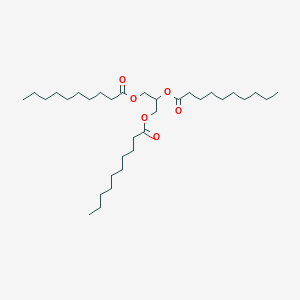| General Information of MET (ID: META00267) |
| Name |
TG(10:0/10:0/10:0)
|
| Synonyms |
Click to Show/Hide Synonyms of This Metabolite
1,2, 3-Propanetriyl-decanoate; 1,2, 3-Propanetriyl-decanoic acid; 1,2,3-Propanol tridecanoate; 1,2,3-Propanol tridecanoic acid; 1,2,3-Tridecanoylglycerol; 1-Animal fats-2-animal fats-3-animal fats-glycerol; 1-Decanoic acid-2-decanoic acid-3-decanoic acid-glycerol; 2,3-Bis(decanoyloxy)propyl decanoate; 2,3-Bis(decanoyloxy)propyl decanoate (acd/name 4.0); 2,3-Bis(decanoyloxy)propyl decanoic acid; Caprate triglyceride; Capric acid triglyceride; Capric triglyceride; Caprin; Decanoate, 1,2,3-propanetriyl ester; Decanoic acid, 1,2,3-propanetriyl ester; Glycerin tridecanoate; Glycerin tridecanoic acid; Glycerol tricaprate; Glycerol tricapric acid; Glycerol tricaprin; Glycerol tridecanoate; Glycerol tridecanoic acid; Glyceryl tricaprate; Glyceryl tricapric acid; Glyceryl tridecanoate; Glyceryl tridecanoic acid; TAG(10:0/10:0/10:0); TAG(30:0); TG 10:0/10:0/10:0; TG(10:0/10:0/10:0); TG(30:0); Tracylglycerol(10:0/10:0/10:0); Tracylglycerol(30:0); Tri-N-caprin; Tri-decanoin; Triacylglycerol; Tricapric glyceride; Tricaprin; Tridecanoin; Tridecanoylglycerol; Triglyceride
|
| Source |
Endogenous;Glycerolipids;Food;Cosmetic
|
| Structure Type |
Triradylcglycerols (Click to Show/Hide the Complete Structure Type Hierarchy)
Lipids and lipid-like molecules
Glycerolipids
Triradylcglycerols
|
| PubChem CID |
|
| HMDB ID |
|
| Formula |
C33H62O6
|
| Structure |
<iframe style="width: 300px; height: 300px;" frameborder="0" src="https://embed.molview.org/v1/?mode=balls&cid=69310"></iframe>
|
 |
|
3D MOL is unavailable
|
2D MOL
|
|
Click to Show/Hide the Molecular/Functional Data (External Links/Property/Function) of This Metabolite
|
| ChEBI ID |
|
| FooDB ID |
|
| ChemSpider ID |
|
| METLIN ID |
|
| Physicochemical Properties |
Molecular Weight |
554.8 |
Topological Polar Surface Area |
78.9 |
| XlogP |
12.2 |
Complexity |
543 |
| Heavy Atom Count |
39 |
Rotatable Bond Count |
32 |
| Hydrogen Bond Donor Count |
N.A. |
Hydrogen Bond Acceptor Count |
6 |
| Function |
TG(10:0/10:0/10:0) or tricapric glyceride is a tridecanoic acid triglyceride or medium chain triglyceride. Triglycerides (TGs) are also known as triacylglycerols or triacylglycerides, meaning that they are glycerides in which the glycerol is esterified with three fatty acid groups (i.e. fatty acid tri-esters of glycerol). TGs may be divided into three general types with respect to their acyl substituents. They are simple or monoacid if they contain only one type of fatty acid, diacid if they contain two types of fatty acids and triacid if three different acyl groups. Chain lengths of the fatty acids in naturally occurring triglycerides can be of varying lengths and saturations but 16, 18 and 20 carbons are the most common. TG(10:0/10:0/10:0), in particular, consists of one chain of decanoic acid at the C-1 position, one chain of decanoic acid at the C-2 position and one chain of decanoic acid acid at the C-3 position. TGs are the main constituent of vegetable oil and animal fats. TGs are major components of very low density lipoprotein (VLDL) and chylomicrons, play an important role in metabolism as energy sources and transporters of dietary fat. They contain more than twice the energy (9 kcal/g) of carbohydrates and proteins. In the intestine, triglycerides are split into glycerol and fatty acids (this process is called lipolysis) with the help of lipases and bile secretions, which can then move into blood vessels. The triglycerides are rebuilt in the blood from their fragments and become constituents of lipoproteins, which deliver the fatty acids to and from fat cells among other functions. Various tissues can release the free fatty acids and take them up as a source of energy. Fat cells can synthesize and store triglycerides. When the body requires fatty acids as an energy source, the hormone glucagon signals the breakdown of the triglycerides by hormone-sensitive lipase to release free fatty acids. As the brain cannot utilize fatty acids as an energy source, the glycerol component of triglycerides can be converted into glucose for brain fuel when it is broken down. (www.cyberlipid.org, www.wikipedia.org). TAGs can serve as fatty acid stores in all cells, but primarily in adipocytes of adipose tissue. The major building block for the synthesis of triacylglycerides, in non-adipose tissue, is glycerol. Adipocytes lack glycerol kinase and so must use another route to TAG synthesis. Specifically, dihydroxyacetone phosphate (DHAP), which is produced during glycolysis, is the precursor for TAG synthesis in adipose tissue. DHAP can also serve as a TAG precursor in non-adipose tissues, but does so to a much lesser extent than glycerol. The use of DHAP for the TAG backbone depends on whether the synthesis of the TAGs occurs in the mitochondria and ER or the ER and the peroxisomes. The ER/mitochondria pathway requires the action of glycerol-3-phosphate dehydrogenase to convert DHAP to glycerol-3-phosphate. Glycerol-3-phosphate acyltransferase then esterifies a fatty acid to glycerol-3-phosphate thereby generating lysophosphatidic acid. The ER/peroxisome reaction pathway uses the peroxisomal enzyme DHAP acyltransferase to acylate DHAP to acyl-DHAP which is then reduced by acyl-DHAP reductase. The fatty acids that are incorporated into TAGs are activated to acyl-CoAs through the action of acyl-CoA synthetases. Two molecules of acyl-CoA are esterified to glycerol-3-phosphate to yield 1,2-diacylglycerol phosphate (also known as phosphatidic acid). The phosphate is then removed by phosphatidic acid phosphatase (PAP1), to generate 1,2-diacylglycerol. This diacylglycerol serves as the substrate for addition of the third fatty acid to make TAG. Intestinal monoacylglycerols, derived from dietary fats, can also serve as substrates for the synthesis of 1,2-diacylglycerols.
|
|
Regulatory Network
|
|
|
|
|
|
|
|
|
 click to show the details of this protein
click to show the details of this protein
 click to show the details of experiment for validating this pair
click to show the details of experiment for validating this pair

